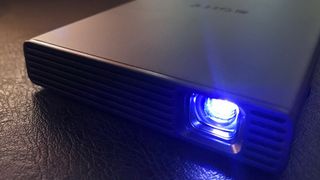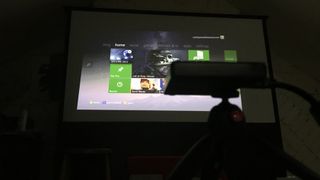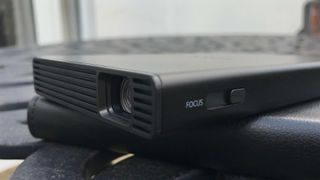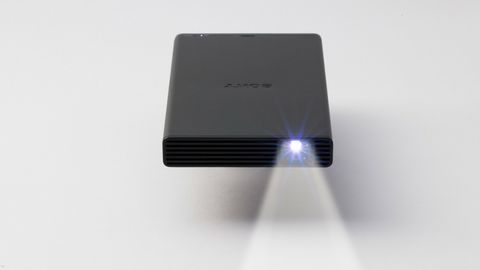TechRadar Verdict
If you do give impromptu presentations and don't want to depend on the quality of tech you find in offices and hotels, the MP-CD1 (preferably outfitted with a small portable speaker and a wireless dongle) will do the job. If you aren't a traveling business person and you're looking for a projector with a bit more brightness, you're best served looking at full-on home theater projectors.
Pros
- +
Ultra-portable
- +
Instant on
- +
USB-C and HDMI
- +
Just enough brightness
- +
Works as a portable battery
Cons
- -
854x480 resolution
- -
80-inches max.
- -
Auto-keystone is hit and miss
- -
Tricky to focus
- -
No Bluetooth
Why you can trust TechRadar
Whatever happened to the 'pico' projector concept? Those small, portable projectors were everywhere at the turn of the decade until being roundly dumped.
I guess I shouldn't be surprised. While portable and functional, these mini beamers lacked the key feature any projector needs: light.
Now on sale for $399 / £449 / AU$535, the all new Sony MP-CD1 attempts to change all that by dramatically boosting brightness from 32 ANSI lumens to 105 ANSI lumens. The trade-off for all that extra brightness, however, is that Sony has also slashed resolution from 1920x720 to a paltry 854x480 pixels.
So, we ask, can less really be more? Read on to find out.

Design
At just 280g (9.9 ounces), the MP-CD1 is portability defined. It's barely any bigger than a six-inch smartphone, measuring 83x16x150mm, and has four rubber feet for staying still (small projectors can easily get tugged about by cables).
On the side is a 3.5mm jack for attaching the MP-CD1 to a small speaker (Bluetooth would have been nicer, since all small speakers have it), though there's also a mono rather loud speaker built-in. It's pretty bad, and best avoided ... though, that's often impossible since the MP-CD1 completely lacks a volume button.
That standby button is also used to switch between bright and normal picture modes, though the difference is subtle.
Also on the side is an HDMI slot, which is there to connect the MP-CD1 to a laptop, and perhaps an occasional games console or disc spinner. It can be wired-up to anything via an adapter (it's MHL-friendly, so plays nice with phones and tablets). It can also be fitted with an optional HDMI dongle that allows wireless streaming and sharing, and crucially, the wireless mirroring of smartphones and tablets.

Setup
Positioning the MP-CD1 was not easy. It's designed to project a maximum 120-inch 16:9 aspect ratio images at a distance of about 3.5m. That sounds great in theory, but in practice the image needs to be smaller, and higher than possible from coffee tables. There is some automatic keystone correction software that rights any awry image in seconds, but it's hit-and-miss, and leaves one side looking wonky.
Moving the MP-CD1 even an inch resets the keystone software, which in turn resets the focus. There is a manual focus slider, but it's very subtle, and focusing can be painstaking as its slider is way too small. If you do need some height – and you almost certainly will – pack a pocket-sized tripod because the MP-CD1 does have a standard tripod thread off-center on its undercarriage.
During our testing, we used one to create a pleasing 60-inch image from around 1.5m from a screen, with an 80-inch image possible from 2.3m. Go any higher and image fades and looks pixelated, even in a blackout.

The MP-CD1 also has a 5,000mAh capacity battery, which in our test ran for just shy of three hours. That's the magic number for a portable projector like this, because although it's not designed for watching movies, it does allow something to be watched without having to think about how long it's going to last.
However, that USB-C slot on the side can be attached to any portable smartphone/tablet power bank, which at a stroke that means no-one ever has to take a proprietary AC adaptor around the world. Rejoice! In the box is a USB-C-micro USB adaptor.
However, the silver lining to all this - and what we liked most about the MP-CD1's setup - was that it was powered-on and good to go in just a few seconds.

Performance
Before we get hyper-critical, let's consider what the MP-CD1 is – a very basic, very portable projector that is mostly about convenience. No-one is going to be watching many movies on the MP-CD1 unless it springs a massive surprise.
It doesn't.
It might be three times brighter that the MP-CD1, but the MP-CD1's 105 lumens get used-by its 854x480 pixel images pretty quickly. Does that mean the still images and spreadsheets we tried ultra-detailed? Of course not. Nor are the colors highly nuanced, but that DLP IntelliBright tech does appear to be doing something good by keeping everything just about bright enough to compete.
It's best used in a blackout, of course, but that's not likely in a scenario where the MP-CD1 is casually used to show photos, or super-size a presentation deck. So to compensate we kept the curtains cracked open to mimic a dingy hotel space or office, and the MP-CD1 rose to the task pretty well.

It turns out that the MP-CD1's lack of pixels is actually a wise way to max-out its brightness, but only if you keep things small. You can get the MP-CD1 to put 120-inches on a wall, but it's a much better, tighter and brighter image if you restrict it to 80-inches. Of course, we're getting into big TV territory there, but only at this size (or smaller) does it pack a punch.
Used for watching a movie in a total blackout, the MP-CD1 produced a reasonably bright 80-inch image image that noticeably lacked contrast, but I didn’t notice any issues with motion blurring or noise.
There is one surprise in that the MP-CD1's battery can also be used to recharge any phone or tablet. That's a clever play to sneak the MP-CD1 onto every business trip regardless of the need for an impromptu presentation.
Verdict
If pico projectors were an idea ahead of their time back in 2009, not a great deal has changed. The MP-CD1 is just about bright enough, but only at the cost of slashing the resolution, and the upsized battery will be inconsequential to most users (if your presentation is over an hour it's definitely too long!). It's also rather odd that Sony has gone with both DLP tech and a low resolution sensor when its MP-CL1A boast a laser light source and 720p HD detail.
Setup is not as simple as it could be, and the lack of a volume rocker is bizarre, but the MP-CD1 produces reasonably impactful 80-inch still images and watchable movies. Does it do enough for the money? Probably not, but if you do give impromptu presentations and don't want to depend on the quality of tech you find in offices and hotels, the MP-CD1 (preferably pimped-up with a small portable speaker and a wireless dongle) will do the job.
...just don't expect an IMAX experience.
Jamie is a freelance tech, travel and space journalist based in the UK. He’s been writing regularly for Techradar since it was launched in 2008 and also writes regularly for Forbes, The Telegraph, the South China Morning Post, Sky & Telescope and the Sky At Night magazine as well as other Future titles T3, Digital Camera World, All About Space and Space.com. He also edits two of his own websites, TravGear.com and WhenIsTheNextEclipse.com that reflect his obsession with travel gear and solar eclipse travel. He is the author of A Stargazing Program For Beginners (Springer, 2015),


